The Swedes may talk about getting “smacked from behind” while the Poles will tell you the tale of “howling kittens.” No matter which country you are in, the people there will have their own way of describing a hangover, and along with it, a likely cure. Most of the homegrown remedies have to do with food, however unappetizing (burnt toast, anyone?), and questionable drinks.
I suggest you steer clear of the surprisingly popular yet grossly unhelpful hair of the dog (drink more of what you had the night before). Instead, you will find it in your best interest to find a hearty local dish, preferably with an egg or two in it. Cysteine, an amino acid found in eggs is said to combat the hangover-causing toxin acetaldehyde. Other helpful members of the food and drink family are water, coconut water (often called nature’s sports drink), prickly pear, banana, and chocolate.
Here are ten soul-satisfying, lip-smacking dishes from around the world that may slow down those nasty needles jabbing away mercilessly at your forehead. They are not necessarily the official hangover cure of your country of choice, but they are easily available and may provide you with the incentive to get up and pull back the thick drapes of your hotel room and venture out.
USA – Eggs Benedict
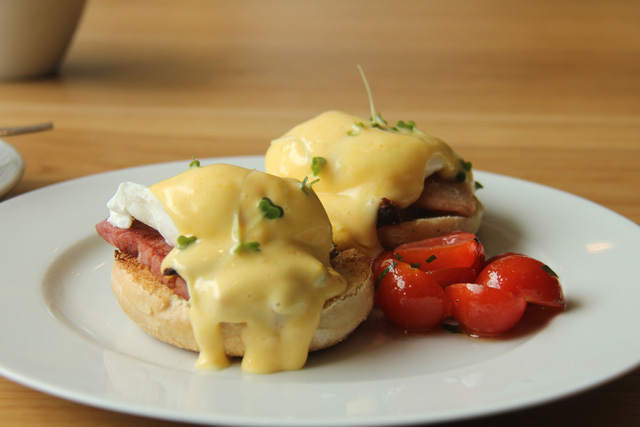
Although the Prairie Oyster, a fierce concoction of tomato juice, Worcestershire sauce and hot sauce topped off by a raw egg is often touted as the go-to remedy in USA, I urge you to keep away from anything that has the word “raw” in its midst. Instead, go for something tastier and healthier, like Eggs Benedict.
[social]
Food historians have two versions to the origins of this dish, but I would like to go with the one that involves a flamboyant New York stockbroker named Lemuel Benedict. Apparently, after a night of indulgence, he ordered two poached eggs, crispy bacon, thickly buttered toast and a pitcher of hollandaise sauce for breakfast. The year was 1894, and the place was the old Waldorf hotel, which was then located at Fifth Avenue and 33rd Street. The maître d’ Oscar (same guy who is credited with the creation of the Waldorf salad) liked what he saw. He promptly tested the innovative dish, made some slight changes (preferring ham over bacon and English muffin instead of toast) and put it on the menu under the name, Eggs Benedict. Thus was born an American classic which would slowly go on to establish itself as a brunch staple and hangover killer.
As many have rightfully pointed out, hollandaise, which is a rich, buttery sauce with hints of lemon and vinegar, may not be suited to the task at hand on account of its gooey texture. But good news is that it contains egg yolks, and eggs as we know help alleviate some of the symptoms of a crushing hangover. So pick up that fork and dig into those quivering eggs, even as you shake your head and say to yourself “never again.”
Read about Regional Foods Around America
Russia – Solyanka
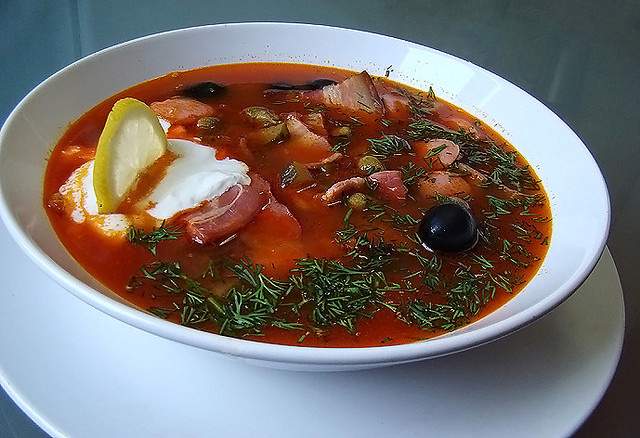
It makes sense that the hangover cure of a particular country is tailor-made for its local brew. In Russia, more often than not, the brew of choice is the colorless Vodka. A pure alcohol with a significantly low level of congeners, Vodka’s foremost after-effect is dehydration. So it is of little wonder that Russians are known to glug pickle juice after a night of carousing. The salty brine makes them drink water, which is exactly what they need.
But that’s not all. There is also this practice of heading to the sauna and sweating out the toxins. And as if that’s not enough, they whack themselves with bundles of soaked birch twigs to boost circulation.
Not one for drinking pickle juice or subjecting one’s hungover self to excess heat and self-inflicted thwacks, I have a better fix in mind – a folksy Russian soup called solyanka. It contains a wide selection of smoked meat (which may or may not include kidneys), chunks of beef, sundry vegetables (cabbage is almost always present), pickles, black olives, lemon slices, capers, and of course, sour cream and dill. There are versions of this soup that involve fish and mushrooms, but most swear by the meaty broth. As with any traditional dish, there is much banter about which method of preparation is authentic and which ingredients are an absolute abomination. The only constant are the brined cucumbers (pickles), which is what make this soup the perfect answer to a Vodka-induced hangover.
Read Beyond Borsch: Different Flavors of Russia
Italy – Pasta Carbonara

Your Italian friends may claim to cure their postumi della sbornia (aftermath of the bender) with a few shots of strong espresso, but you can do better with something more filling, especially if you don’t want to curl up in bed for the rest of the day. To this very purpose, I recommend pasta carbonara, which is basically a spin on an age-old hangover slayer, bacon and eggs.
This dish is usually made by tossing warm spaghetti with a delightfully creamy, egg-based sauce, to which is added a smattering of minced, salty, pancetta. Freshly grated parmesan and few rounds of black pepper add the finishing touch. Bacon or guanciale is often used in place of pancetta, and it’s all good as long as artificial flavors like maple are not thrown into the mix. Also frowned upon by Italians is the use of actual cream in the sauce, for they believe the creamy texture is something to be attained by whisking the egg and cheese, not by adding a dollop of cream.
Apart from being full of comforting flavors, the slow release of carbohydrates from the pasta will keep you charged throughout the day. Once you master the tricky sauce, you can whip up this Italian delight within the confines of your kitchen, provided you consider yourself fit enough to work with fire and knives.
Check out our Italy Indie Travel Guide and read Eat Your Way Through Italy: 4 Stops on an Italian Foodie Tour
Canada – Poutine
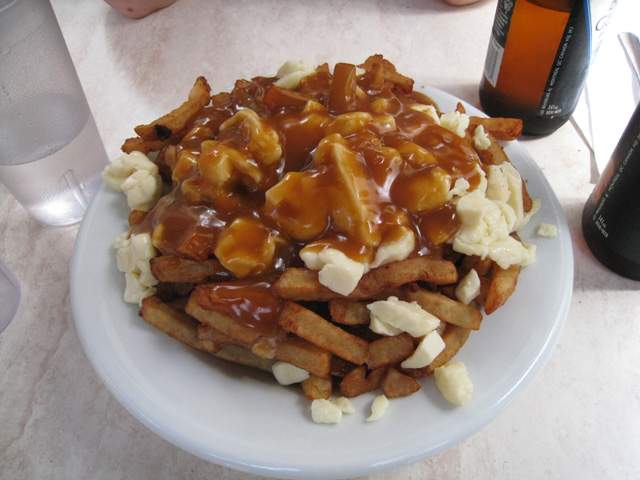
Fatty, starchy, salty, greasy – these are just some of the words used to describe the increasingly popular Quebec culinary tradition, the humble poutine. Often used to mean a mess, the French word “poutine” may well have some connection with the English “pudding.” Although it originated up North in rural Quebec sometime in the late fifties, these days it can be found all over Canada, and it is slowly making its way to many foodie cities and towns of US.
A daunting mound of fluffy yet crispy fries are sprinkled with fresh cheese curds, and then smothered with rich, hot gravy, making this number the ideal candidate for post-booze cravings. The curds are small nuggets of cheese, usually cheddar, and produce a distinctive squeaking sound when you munch on them. It’s a sign of freshness, not the ill-effects of a deadly hangover.
As with any dish, there are variants, and some of them use blue cheese, some douse the heaping fries in spaghetti meat sauce, and then there are those who add nutrients by way of green peas and shredded chicken. For the fancier set, there is foie gras gravy sauce and fries cooked in duck fat. The options are endless, and often unnecessary when the objective is as simple as subduing a hangover. Just ask for a no-frills plate of sloppy poutine, the sloppier the better, and dive right into it before the fries lose their crunch.
Read 20 Luxurious Wineries and Wine Hotels Where You Can Stay the Night
Germany – Rollmops
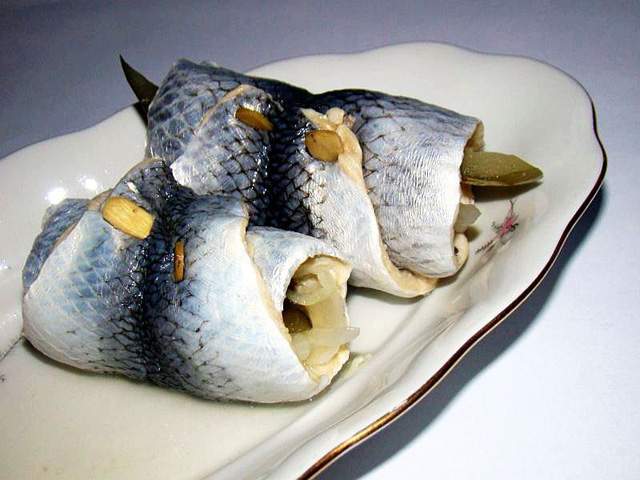
Home to Oktoberfest and legendary beer brewing traditions, Germany is no stranger to hangovers, which they refer to as katzenjammer, or wailing cats. And like their Polish neighbors, the Germans believe in the power of the pickle. Rollmops, that is, fillets of pickled herring wrapped around bits of gherkin and onion, is an essential part of their morning-after ritual. Thick, buttered crusty bread is optional. The word herring means “army” in Old Norse, and sometimes, that’s what you need to shush the wailing of the cats.
It may seem odd to start your day with fishy fare, but if you can get past the first tangy bite on an empty stomach, you will find this popular, old-school Northern Europe specialty to be quite appetizing. Also, being a good source of omega 3 fatty acids makes this dish nutritious as well. But how does it help tackle the symptoms of a night of revelry? Well, the brine in rollmops replenishes electrolytes and the saltiness makes you thirsty for that all important cure-all, water.
You can buy jars of these vinegary snacks off the shelves of any deli or supermarket in Germany. Store a few in your fridge before you put on your party hat. This tip will particularly come in handy when you stagger out of a spinning bed the next morning and realize that you need something other than willpower to be able to face the loud and bright world waiting outside your door.
Read Germany by the Glass: Three Drinking Destinations Not to Miss
Japan – Miso Soup

When translated, the Japanese word for hangover, futsukayoi, means “two days drunk,” and if you find yourself in that state in the Land of the Rising Sun, put the chopsticks aside and pick up the soup spoon. It may so happen that the specialty hangover tonics crowding the convenience stores may look alluring after a few too many, but I would suggest you slurp down a bowl of wholesome miso soup instead. It is the traditional remedy and not without its reasons.
Chopped scallions, cubes of tofu, seaweed and dashi stock combine with miso paste to create a soothing broth that helps restore fluids, salts and other nutrients to your body. As with all soups, there are variations which may include vegetables, mushrooms, seafood, and noodles. As the warm miso soup trickles down your throat and the umami flavors begin working their magic, everything around you will seem more pleasant and the day ahead a lot less dreary.
Later, if your palate permits, you could try a side of umeboshi, which is well, similar to pickled plums. When cured with sea salt for several months, this Japanese ume fruit is a force to reckon with. Sour, crinkly and salty to a fault, the electrolyte-rich pickled wonders are the perfect pick-me-up. And guess what, your liver and digestive system will thank you for it.
Read 20 Unique Drinks to Sample on Your Next Trip
Ireland – Irish Fry Up
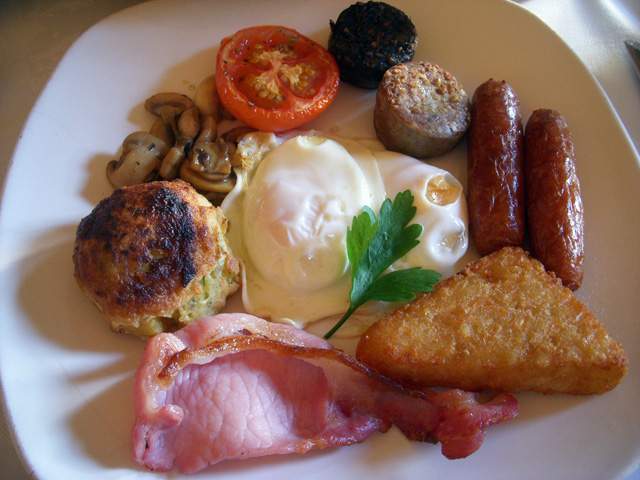
While there are folks who will swear by the Full Fry Up (English, Scottish, Welsh, or Irish) after a night on the sauce, there are others who will say that lining your stomach with grease is best done before you order that round of drinks. If you ask me, it works just as well the morning after. The body gets diverted by the onslaught of proteins and carbohydrates brought on by a full breakfast, and the hangover is forgotten for a while.
Of course, there are variations to the Full Irish depending on which part of the Emerald Isle you are visiting, and given the fact that this fried excess has often been called “artery clogging,” nowadays you may find most of your items grilled instead of fried. To begin with you can expect fried eggs, bacon, sausages, black and white pudding, soda bread, tomato, baked beans, mushrooms, potato farls (or boxty), toast, and pots of steaming tea. The “pudding” part of the dish has nothing to do with dessert and everything to do with sausage, with the dark one being the fearful blood sausage.
You may want to skip the gloppy beans and anything else which seems unmanageable in your delicate state, and instead tuck into the crispy, lean Irish bacon, the eggs, and the carb-loaded bread and potatoes. As for the tea, quaff as many cups as your foggy brain desires. Brimming with antioxidants, the potent liquid will help clear the cobwebs.
Read 10 Experiences All Travelers Should Have in Ireland
Israel – Shakshuka
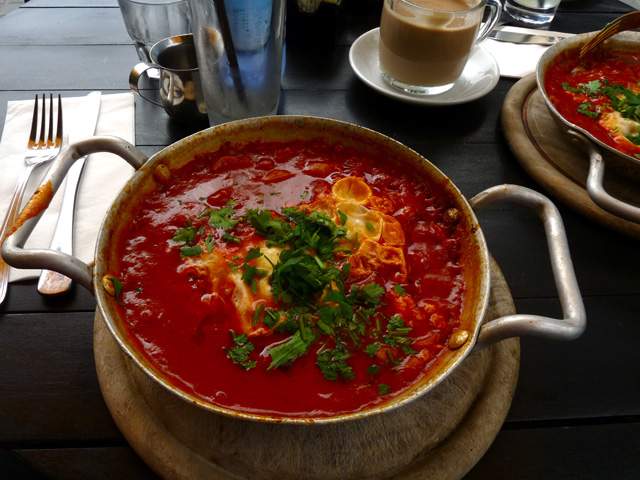
Shakshuka is a word which could have you fall back on the good old “point and nod,” for it may not easily roll off your tongue after a night on the town. The name can sound almost like a war-cry if said with enough conviction, but the taste is, in fact, just the opposite. Eggs poached in a rich, peppery tomato sauce, shakshuka is comfort food at its best.
Onion, garlic, herbs, and fiery spices make their way into the simmering sauce. Olive oil is favored over butter, keeping in step with the Mediterranean flavors. And of course, some sort of flatbread, pita or otherwise, is a must for sopping up all the juices. Loosely translated, shakshuka means “all mixed up” in Hebrew, and as many have pointed out, there are no set rules for its preparation. Many countries, particularly those of North Africa and the Middle East have similarly inspired fare. Muddy origins and variations notwithstanding, it is as much a part of Israeli culinary tradition as falafel and hummus.
If you are still reeling from the effects of the night before, don’t skimp on the smoky paprika and cumin, both essential to the tomato base. Your body will turn its attention to the spices and delay the hangover, which may eventually lessen the impact altogether.
Check out our Israel Indie Travel Guide and read Why Israel and the Palestinian Territories Should Be on the Backpacking Trail
Switzerland – Rösti
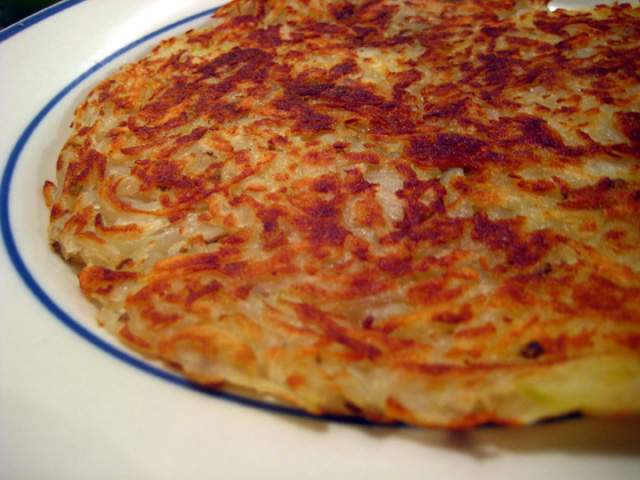
You may wonder why one of the richest countries in the world would choose rösti, a simple peasant dish consisting primarily of fried potatoes, as their national dish. You may even feel inclined to brush it aside as some sort of glorified hash brown. But next time you find yourself in Switzerland, nursing an Alpine hangover, you may want to order a plate of rösti, with or without a side of smoked ham and local cheese. Either way, it won’t let you down.
Fancy pronunciation (it is pronounced reursch-ti, not row-sti) aside, what sets it apart from the ordinary potato pancake is the way the waxy, matchstick-like, grated potatoes get all golden-brown and crispy on the outside, ragged around the edges, but still manage to remain buttery soft inside. That and the absence of flour of course.
Except for the generous dose of starch, which might help in improving your sagging energy levels, this breakfast staple doesn’t seem to have a lot going for it , especially in terms of a hangover fix, so what is it doing here? Well, although this modest dish does nothing to release toxin-eliminating amino acids and such, it has a higher purpose. Made up of the universal feel-good twosome, butter and potatoes, a plateful of rösti makes you feel better, even happier. Cut yourself a thick wedge, pour a mug of steaming coffee, sit back, and let the Alpine air do the rest.
Read Alcohol and Adrenaline – A Match Made in Heaven
Korea – Haejang Guk

When it comes to beating your hangover with a meat-laden, spiced-up broth, few can beat the popularity of tripe (the lining of a cow’s stomach) soup. It is what the Greeks have dubbed patsa, the Mexicans know it as menudo, the Turks call it işkembe çorbası, and the Koreans like their haejang guk. Hailing back to the beginning of the Korean dining-out culture, haejang guk has many variants, the most common being the one which includes some sort of pork or beef stock, long-simmered chunks of tender meat (may need to be plucked off the spine), thickened cow (or pig) blood, plenty of cabbage, green onions, and of course, the afore-mentioned tripe. Surrounded by condiments like kimchi, dried salted seaweed, sliced green chillies and pickled shrimps, and the customary bowl of white rice, this hearty stew is not for the faint of the heart.
Sold from street stalls and in gritty restaurants, the main feature of this dish can be anything from bean sprouts to chewy marsh snails. When battling the aftermath of a soju-soaked night, do you even care whether your soup has tripe, or say, snails? All that matters is that the bowl of haejang guk tastes good (which it sure does), is filling, and that it keeps you from collapsing into a heap on the floor.
And if you are wondering, the reason why it works as a formidable hangover chaser is mostly on account of the high protein content and the eye-watering Korean spices. Your body begins to work on the soup and for the time being, forgets all about the post-party toxins, thus alleviating the effects of the hangover.
Read Dumpling Impulse: Discovering Mandut Guk in Seoul
Check out more articles about eating and drinking on BootsnAll:
- How to Get Drunk Around the World: 5 Countries & Their Drinking Rules
- Beyond Wine and Beer: 8 Famous Local Drinks to Taste Around the World
- Ten Places to Get Drunk and Call it a Cultural Encounter
- 10 Famous Cocktails and Where They Were Born
- 8 Reasons to Quit Your Diet in Buenos Aires
- India’s Top Roadside Eateries
- 11 Traditional Breakfasts From Around the World
Photo credits: Jon Mountjoy, Paseo # 11, johnlee104@gmail.com, The Kozy Shack, Wikimedia Commons, quinn.anya, LWY, Neta Gov, Caitlinefa, Wikimedia Commons.
